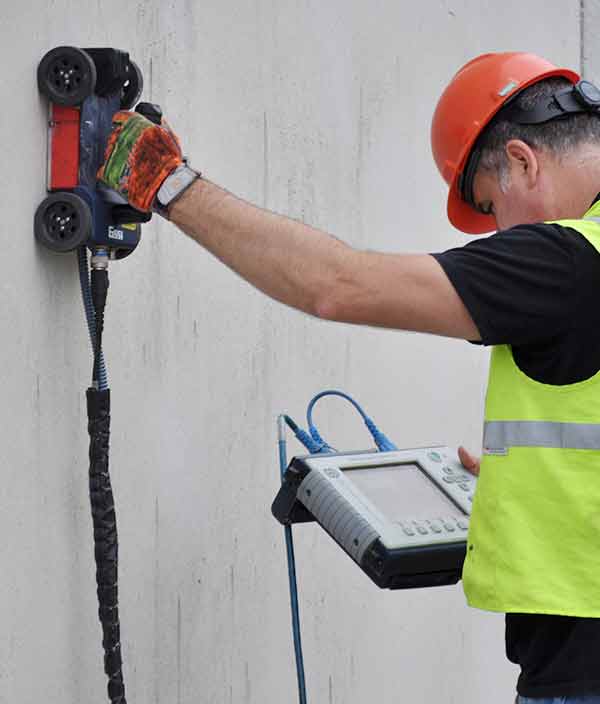Local RainierGPR Service Areas for Accuracy Concrete Scanning
Local RainierGPR Service Areas for Accuracy Concrete Scanning
Blog Article
Concrete Scanning: A Crucial Action In The Direction Of Ensuring Architectural Honesty and Security
In the world of construction and framework maintenance, the significance of concrete scanning can not be overemphasized. By employing sophisticated innovation and approaches, concrete scanning offers as a critical device in guaranteeing that the integrity and security of bridges and buildings are promoted to the greatest standards.
Value of Concrete Scanning
Concrete scanning plays an important duty in guaranteeing the structural integrity and security of structures and infrastructure jobs. By making use of advanced innovations such as ground-penetrating radar (GPR) and electromagnetic induction, specialists can non-destructively inspect concrete structures to identify prospective issues, voids, embedded things, and support layout. This process allows very early discovery of anomalies that might jeopardize the security of a framework, preventing expensive damages and guaranteeing the security of passengers.
Concrete scanning is particularly crucial during the planning and building and construction stages of a project. Before drilling, cutting, or coring into concrete, scanning helps determine the exact places of rebar, post-tension cords, and other ingrained aspects, minimizing the danger of unexpected hits that could result in structural weaknesses. Additionally, concrete scanning aids in high quality control by verifying the density of concrete covers and detecting any discrepancies that may affect the overall durability of the structure. Inevitably, purchasing concrete scanning solutions is not only a proactive measure to mitigate dangers yet additionally a basic action in the direction of preserving the long-term safety and stability of structures and facilities.
Modern Technology for Concrete Evaluation

Advantages of Very Early Discovery
Timely detection of architectural concerns can considerably alleviate dangers and ensure the long life of building and construction tasks. By identifying potential problems at an early stage in the construction process, stakeholders can take aggressive procedures to attend to problems before they intensify right into larger and much more costly problems. Among the essential benefits of early discovery is the avoidance of structural failures, which can pose serious safety and security risks and bring about job delays and financial losses.
Furthermore, early discovery enables for prompt repairs and upkeep, which can assist extend the life expectancy of the structure. By addressing problems promptly, construction groups can prevent costly fixings and even the demand for premature replacement of architectural components. This aggressive strategy not only saves money and time but additionally improves the general safety and durability of the building and construction job.
In addition, very early detection can boost project preparation and decision-making by providing stakeholders with important understandings into the problem of the structure. Equipped with this information, task managers can make enlightened choices pertaining to building techniques, products, and timelines, causing much more successful and effective project results.
Ensuring Structural Security
Making sure the structural stability of a construction task is paramount to its safety and longevity. Concrete scanning plays an essential role in guaranteeing structural security by detecting possible problems such as spaces, delamination, or reinforcement corrosion that could endanger the honesty of the structure over time.
By using sophisticated scanning technologies like ground-penetrating radar (GPR) and electromagnetic induction, building and construction specialists can non-invasively evaluate concrete frameworks to determine areas of problem under the surface area. This positive method allows for the very early detection of issues or weaknesses, allowing punctual repairs or support to avoid architectural failures.
Normal concrete scanning during different building and construction stages and throughout the life cycle of a framework can assist maintain its security, reduce threats, and make sure the safety of occupants. By focusing on structural security via concrete scanning, building jobs can boost their durability and sturdiness, ultimately adding to better safety and long life.
Preventing Essential Failings
To secure versus devastating occasions, meticulous tracking and proactive upkeep are crucial in averting vital failings within structural frameworks. Discovering possible issues before they intensify is vital to avoid architectural failings. Implementing routine inspections, such as concrete scanning, can reveal concealed flaws like spaces, cracks, or deterioration that could jeopardize the honesty of a framework. By utilizing sophisticated scanning technologies like Ground Permeating Radar (GPR) or Concrete X-ray, designers can non-destructively assess the look here problem of concrete and identify powerlessness that call for support or repair - RainierGPR Service Areas.

Verdict
To conclude, concrete scanning plays a vital function in guaranteeing structural integrity and safety by using sophisticated innovation for early detection of possible concerns. This proactive approach aids protect against essential failings and guarantees the security of frameworks. It is important to prioritize concrete evaluation as a basic practice to safeguard the longevity and safety and security of structures and facilities.
Concrete scanning plays an essential function in guaranteeing the structural honesty and security of structures and facilities projects. Additionally, concrete scanning aids in quality control by validating the thickness of concrete covers and spotting any kind of disparities that might affect the total sturdiness of the structure. Concrete scanning plays an important role in making sure structural security by detecting prospective problems such as gaps, delamination, or reinforcement deterioration that could endanger the stability you can try this out of the structure over time.

In verdict, concrete scanning plays a critical duty in making certain architectural honesty and safety and security by making use of sophisticated innovation for early detection of prospective problems.
Report this page